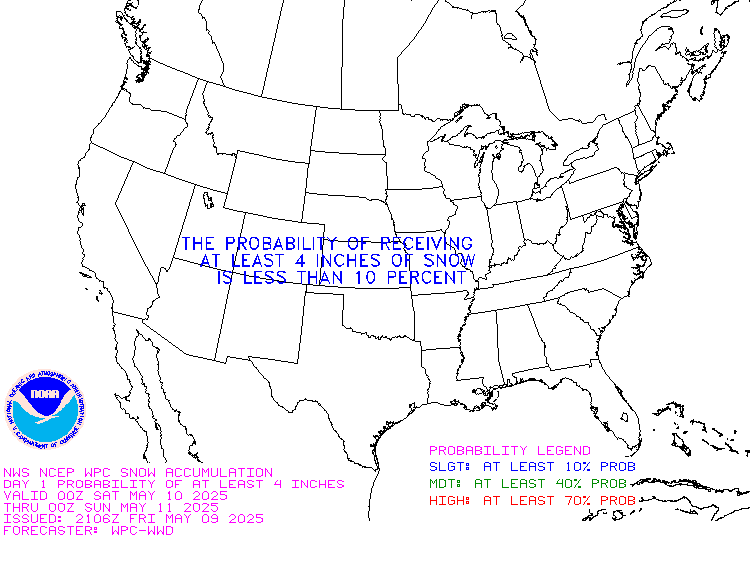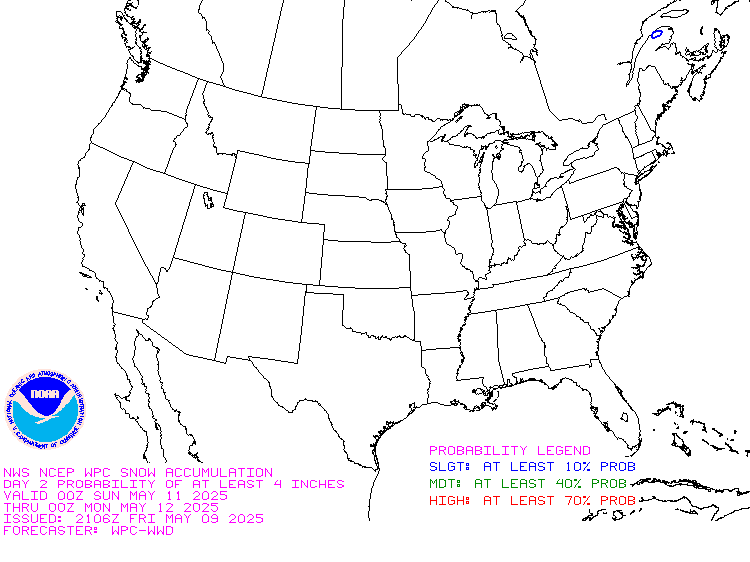This article focuses on what we are paying attention to in the next 48 to 72 hours. The article also includes weather maps for longer-term outlooks and a six-day World weather outlook which can be very useful for travelers.
We start with the U.S. Information. That is the longest part of the article. Then we have a short section on World Weather and then we address the Tropics. When there are tropical storms that might impact the U.S. we provide more detailed information which updates frequently on those storms.
Please click on “Read More” below to access the full report as I have moved the highlights into the body of the report where it is followed by the Today, Tomorrow and the Next Day maps and a lot more. I will try to feature the most important graphic in the lede paragraph on the home page. But there are often multiple maps that are very important so it is best to read the full article. We now have a snow report and it is possible to get a ten-day NWS forecast for the zip code of your choice.
| Notices: What would you like to learn about? Please provide that to me via the comment section at the end of the article. |
First the highlights from the NWS.
Short Range Forecast Discussion
NWS Weather Prediction Center College Park MD
Sun Dec 24 2023
Valid 12Z Sun Dec 24 2023 – 12Z Tue Dec 26 2023…Heavy rainfall and flash flash flooding potential shifts east from the
Southern Plains to the Central Plains and central Gulf Coast today, then
into the Southeast on Christmas Day……Confidence continues to increase for a significant winter storm to
impact parts of the Central Plains and upper Midwest for both Christmas
Eve and Christmas Day, resulting in a White Christmas and treacherous
travel……Unusually mild temperatures along and east of the Mississippi River
with some record breaking warmth possible in the Midwest and Great Lakes
both Christmas Eve and Christmas Day…
Now more detail on the 48-Hour Forecast (It is a 48 to 72 Hour Forecast actually)
Daily weather maps. The Day 1 map updates twice a day and the Day 2 and 3 maps update only once a day. These maps update automatically. But if that does not happen, you can get updates by clicking HERE
TODAY (or late in the day the evening/overnight map will appear) (Key to surface fronts shown on maps and you will then also be able to insert a city name or zip code and get a local NWS forecast).
TOMORROW
NEXT DAY
This animation shows how things may play out over the next 60 hours. To update click here.
The NWS Climate Prediction Center’s: Watches, Warnings, and Advisories plus other information can be found HERE. We post at least one of those updates daily, sometimes both. The Highlights are shown in the lede paragraph of this article.
ATMOSPHERIC RIVERS
This tells us what is approaching the West Coast. Click HERE to update If I have not gotten around to doing the update. Here is some useful information about Atmospheric Rivers.
Continuation of the NWS Short Range Forecast. It is updated by NWS twice a day and these updates can be found here
A low pressure system currently developing over the central Plains in
conjunction with an amplifying upper-level trough dipping into the
northern Plains are setting the stage for more active weather to come
across much of the central to eastern U.S. just in time for Christmas
holiday activities through the next couple of days. Warm and moist air
from the Gulf of Mexico is streaming northward across the western Gulf
Coast region into the southern and central Plains ahead of the developing
low pressure system, producing widespread moderate to heavy rainfall from
the upper Texas coast to the Louisiana coast while bands of heavy rain
with embedded thunderstorms are marching eastward across Kansas, Oklahoma
and Texas ahead of a cold front this Sunday morning. Meanwhile, a cold
air mass from Canada is dipping into the northern portion of the U.S.
Areas of snow over the central Rockies are beginning to extend northeast
into the central Plains toward the northern Plains behind the low pressure
system. The complex interaction among the low pressure system, the
upper-level trough, and the cold air mass is forecast to kick the entire
system farther east toward the Mississippi Valley by tonight, before a
more rapid intensification of the low pressure system expected to take
place over the western portion of the Midwest by Christmas Day. A swath
of showers and thunderstorms ahead of the cold front will steadily shift
eastward through the Deep South, reaching into the Southeast by Christmas
Day. The highest threat of heavy rain and flash flooding is expected to
likewise shift eastward while remaining near the Gulf Coast. Less
rainfall is expected farther inland. By Monday night into Tuesday
morning, the rain and embedded thunderstorms should slow their progression
over the Southeast while spreading farther north into the Appalachians,
Ohio Valley, and the upper Midwest.As the low pressure system begins to intensify more rapidly Monday night
into Tuesday morning, strong and gusty winds are expected to increase and
expand further across the north-central U.S. With cold air being wrapped
around this intensifying storm, the chance of a blizzard has continued to
increase across the northern Plains, with Monday night to Tuesday morning
being the estimated time frame for the most impactful conditions to occur.
Over a foot of snow can been expected along with gale force winds in the
affected areas. In addition, icing will likely be an issue farther east
and northeast from the northern Plains to Minnesota during this period.Over the Pacific Northwest, moisture from the next Pacific cyclone is
forecast to reach the coast on Christmas Day before reaching well inland
by Tuesday morning. Heavier precipitation totals are forecast for the
Olympics and the Cascades, especially by Monday night into Tuesday
morning. Mixed precipitation is forecast for the interior Washington and
Oregon by Tuesday morning.Temperatures will be rather warm for Christmas from much of the Midwest to
the East Coast through this extended holiday weekend. Record warm minimum
temperatures will be common in the Midwest where many low temperatures
will be considerably higher than the average high temps for late December.
Even parts of the southern Plains and mid-Mississippi Valley may witness
record breaking warm highs and lows today Christmas Eve. By Christmas
Day, the most unusually mild temperatures are expected in the upper
Midwest and Great Lakes where highs could range between 15-25 degrees
above normal. The East Coast will not witness quite the anomalous warmth
that the Midwest and Great Lakes will, but daily average temps will still
be rather mild and could still range between 10-15 degrees above normal in
parts of the Northeast by Christmas Day. In contrast, the
central/southern Plains and central/southern Rockies will be the coolest
versus normal thanks to a recent cold frontal passage injecting the region
with an air-mass that feels a lot more like Christmas compared to their
neighbors on the East and West Coasts.
Learn about wave patterns HERE.
Below is the current five-day cumulative forecast of precipitation (Updates can be found HERE)
Ski SnowReports
New Feature – Ski Reports. It is difficult to find reports that auto-update on-screen (and they are very long) but these links will get you to them – If you have additional suggestions make them in the comments section after every Econcurrents Article and we may add those links. We will try to not have too much overlap as that can add to the confusion.
Snow Forecasts. And remember this shows natural snow. Ski resorts also make their own snow.
Day 1

Day 2

Additional snow information can be found here and here. The second link provides animations.
Now we look at Intermediate-Term “Outlook” maps for three time periods. Days 6 – 10, Days 8 – 14, and Weeks 3 and 4. An outlook differs from a forecast based on how NOAA uses these terms in that an “outlook” presents information as deviation from normal and the likelihood of these deviations.
Below are the links to obtain updates and additional information. They are particularly useful if you happen to be reading this article significantly later than when it was published. I always try to provide readers with the source of the information in my articles.
| Days 6 – 10 (shown in Row 1) | Days 8 – 14 (Shown in Row 2) | Weeks 3 and 4 (Shown in Row 3 but updates only on Fridays) |
| https://www.cpc.ncep.noaa. gov/products/predictions/610day/ | https://www.cpc.ncep .noaa.gov/products/predictions/814day/ | https://www.cpc.ncep.noaa.gov/products/predictions/WK34/ |
Showing the actual maps. They should now update automatically. The Week 3 – 4 Outlook only updates on Fridays. So below is what I call the Intermediate-term outlook. On Fridays, it extends out 28 Days. That declines day by day so on Thursday it only looks out 22 days until the next day when the Week 3 – 4 Outlook is updated and this extends the outlook by one additional week.
| 6–
10
|
|
|
| 8–
14 |
|
|
| 3–
4 |
|
|
HAZARDS OUTLOOKS
Click here for the latest complete Day 3 -7 Hazards forecast which updates only on weekdays. Once a week probably Monday or Tuesday I will update the images. I provided the link for readers to get daily updates on weekdays. Use your own judgment to decide if you need to update these images. I update almost all the images Friday Night for the weekend edition of this Weather Report. So normally readers do not need to update these images but if the weather is changing quickly you may want to.
Temperature month to date can be found at https://hprcc.unl.edu/products/maps/acis/MonthTDeptUS.png
Precipitation month to date can be found at https://hprcc.unl.edu/products/maps/acis /MonthPNormUS.png
World Forecast
Below are the Day 1 -3 and 4-6 forecasts for temperature and precipitation. Updates and much additional information can be obtained HERE
World Temperature Anomalies
World Accumulated Precipitation
This information is provided by the University of Maine. They draw upon many different sources. There is a lot of information available at the link provided. I have just provided two useful forecasts. There are probably over a hundred different forecasts available from this source.
Worldwide Tropical Forecast (This is a NOAA Product)
This graphic updates on Tuesdays) If it has not been updated, you can get the update by clicking here Readers will only have to do that if they are reading this article much later than the date of it being published.
Information on Tropical Storms can be found HERE. Western Pacific information can be found HERE.
–
| I hope you found this article interesting and useful. |
–
